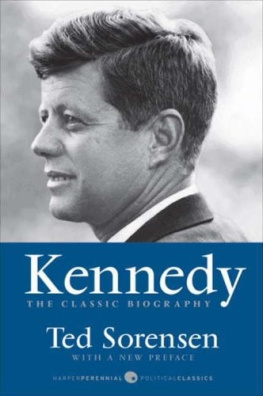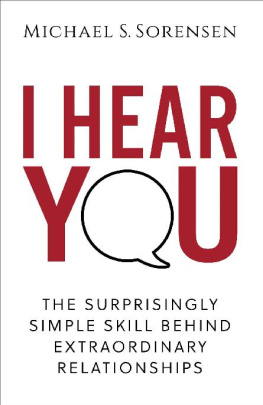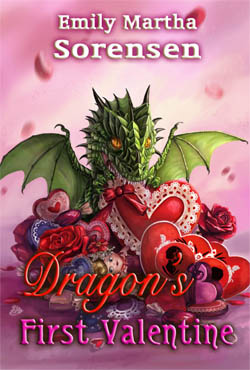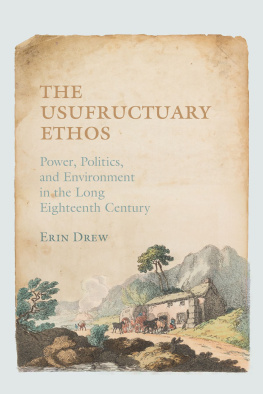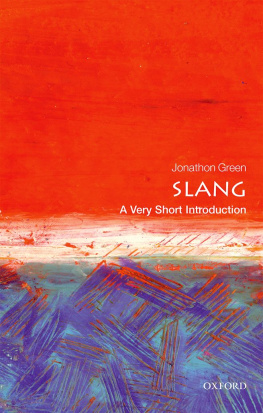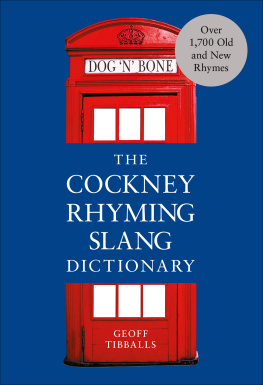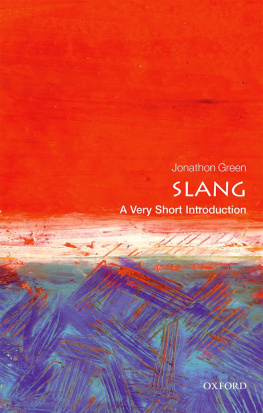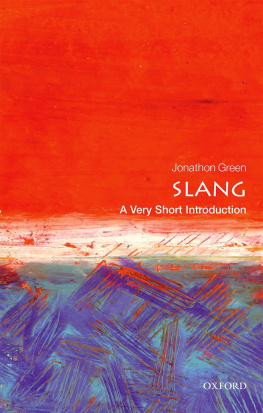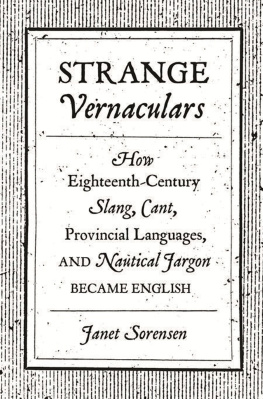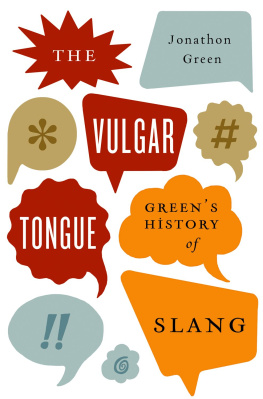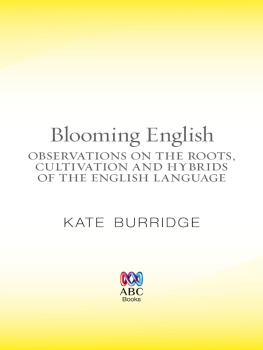
STRANGE VERNACULARS
Strange Vernaculars
HOW EIGHTEENTH-CENTURY SLANG, CANT, PROVINCIAL LANGUAGES, AND NAUTICAL JARGON BECAME ENGLISH

Janet Sorensen
PRINCETON UNIVERSITY PRESS
PRINCETON & OXFORD
Copyright 2017 by Princeton University Press
Published by Princeton University Press,
41 William Street, Princeton, New Jersey 08540
In the United Kingdom: Princeton University Press,
6 Oxford Street, Woodstock, Oxfordshire OX20 1TR
press.princeton.edu
All Rights Reserved
ISBN 978-0-691-16902-6
Library of Congress Control Number: 2016955222
British Library Cataloging-in-Publication Data is available
This book has been composed in Miller.
Printed on acid-free paper.
Printed in the United States of America
10 9 8 7 6 5 4 3 2 1
For Benjamin and Mattias Hoz
CONTENTS
ACKNOWLEDGMENTS
IN THE TOO MANY YEARS it has taken me to complete this book, I have been the fortunate recipient of all manner of support. My editor at Princeton University Press, Anne Savarese, has been steadfastly in my court, at all points both judicious and kind. I thank my lucky stars for her. Katherine Harper provided meticulous and persevering copyediting, for which I am grateful. Ellen Foos and her team at the Press have shepherded the project through production with care and good cheer. To my anonymous Press readersI wish you could know fully how much your generosity meant to me. To Ian Duncan, Steve Goldsmith, and Roxann Wheeler, who gave me the gift of reading so much of this manuscript and counsel to see it through, I hope you do know.
Institutional assistance allowed me time in the archives and space, figurative and literal, to think and write. I am beholden to the National Endowment for the Humanities, the Indiana University Arts and Humanities Initiative, the University of California at Berkeley Division of Arts and Humanities, the University of California at Berkeley Townsend Center for the Humanities, the Andrew Mellon Foundation, and the Newberry Library for crucial funding. The Departments of English at the University of California at Berkeley and Indiana University and a series of charitable chairs of those departments helped negotiate the time I needed for research.
Whether with provocative questions or insights offered after careful reading of a chapter or chapters of the manuscript, an invitation to share work in a variety of forums or a home shared for thinking, particularly in the frantic period near this books completion, or even an encouraging word when the too many years were adding up, the following friends and colleagues have helped me in ways they do and perhaps do not know: Srinivas Aravamudan, Oliver Arnold, Frank Banta, Stephen Best, Purnima Bose, Patrick Brantlinger, Marshall Brown, James Bunn, Miranda Burgess, Shannon Chamberlain, Adriana Craciun, Nigel Davey, James Davies, Sheila Davies, Leith Davis, JoEllen Delucia, Daniel Dewispelare, Jonathan Elmer, Mary Favret, Stephanie Foote, Lynn Festa, Penny Fielding, Anne-Lise Franois, Kevis Goodman, Marjorie Goodman, Kristin Hanson, Simon Joyce, Valerie Kratzer, Celeste Langan, Nigel Leask, David Lieberman, Jessica Ling, Deidre Lynch, Ruth Mack, Susan Manning, Michael McKeon, Richard Nash, Daniel OQuinn, Joanna Picciotto, Gary Pool, John Richetti, Elisa Salasin, Clifford Siskin, Katie Snyder, Daniel Soto, Susan Walker, William Warner, Nicholas Williams, and Eric Weiner. Whatever contributions this book makes are largely due to their critical acumen and warm encouragement. Any errors and missteps, of course, remain my own.
The staff of the following libraries were enormously helpful: the Lilly Library at Indiana University; the Bancroft Library at the University of California, Berkeley; the Lewis Walpole Library; Newcastle City Library; Newcastle University Philip Robinson Library; the University of Manchester Library; the University of Glasgow University; the National Library of Scotland; National Archives of the United Kingdom; Caird Library and Archive at the National Maritime Museum; the British Library; the University of Chicago Library; and the Newberry Library.
My father, the child of immigrants, was my first introduction to those odd terms in English that seemed both inside and outside of the language. He passed away before seeing this book. Heres my two bits, Dad. My sister, Susan Holt, did some mighty heavy lifting with family duties in Chicago in the final hours of this book, for which I am forever in her debt. My familymother, aunts, uncles, nieces, and cousinshave always made Chicago a sweet home, my work there, pleasure. My final words, for now, are for my husband and son, Benjamin and Mattias Hoz, who have not only put up patiently with my passion for words, even when it took me away from them, but have provided the physical and emotional sustenanceand comic reliefthat allowed me to keep at it.
STRANGE VERNACULARS
Introduction
EIGHTEENTH-CENTURY BRITISH READERS were anxious to learn and master the English that was being standardized throughout the centuryso much so that they made grammar books bestsellers and, when they could not afford Samuel Johnsons famous Dictionary of the English Language (1755) in its entirety, bought it in serial form, week by week. If the naughty words excluded from proper print seem far afield from harmless regionalisms and technological jargon, what they share in eighteenth-century print collections and representations is a tantalizing obscurity and an association with the common people, an intersection Strange Vernaculars explores.
Scholars have long discussed the printed texts that helped standardize English, and the relation of these texts to the formation of a British national identity. These works, which I call print institutions of the vernacular, reveal how strange and estranged languages, even or especially in their obscurity, came to be claimed as British, making for complex notions of the nation and the strangers who composed it.
That the vernacular is in many ways strange is a less-surprising notion when we remind ourselves that, as Michael Warner has observed, nations are a way of organizing strangers. That sense of otherness, in the form of linguistic obscurity, permeates the printed works instituting a national vernacular in the eighteenth century.
That linguistic otherness can be disquieting, literally so in the printing of strange languages that attempt to reproduce the audible difference of odd words through phonetic intonation, as in the cant phrase rumbo ken (a pawn shop) or the provincial scolding expression chell baste tha. Indeed, the establishment and exclusion of such noise is the dynamic underwriting one model of communication. The representations of language under study here, however, suggest a model that moves between exclusions and inclusions, with the excluded noise, sometimes defining community by way of contrast, but those same strange sounds also sometimes seen as making up separate languages and communities that must in turn themselves be incorporated within the nation.
Tying languages that defy the norms of standard Englishstrange languagesto a rhetoric of English liberty, Grose and others make curious, sometimes even inscrutable, words into signs not of underworlds or amusing outliers but of Britishness itself. Todays sense of slanga lingo trafficked in by inventive, streetwise strangers, but also, intriguingly, part of our free, living languageemerges in this period and is in part shaped by this refiguring of criminal cant.
Next page

